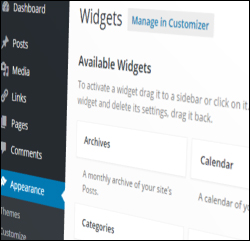 As we have discussed in this post, one of the many benefits of using the WordPress CMS platform is that WordPress makes it very easy to add content, enhance your site, and rearrange the site’s layout with no code editing skills or knowledge required.
As we have discussed in this post, one of the many benefits of using the WordPress CMS platform is that WordPress makes it very easy to add content, enhance your site, and rearrange the site’s layout with no code editing skills or knowledge required.
WordPress gives you the ability to quickly and easily insert, delete, and reorganize various blocks of content in your blog’s sidebar area (and header and footer sections too, depending on what theme you use) using widgets.
Once you know how to use widgets, you can easily add things to your site’s sidebar area (plus headers and footers and other areas, depending on your theme) like:
- nested page lists
- content categories
- archived content posts
- custom menus
- links to external sites
- posts that you want to promote
- post comments
- clickable text ads
- testimonials
- poll questions & results
- content from RSS feeds
- member login section
- videos
- Facebook feeds
- add widgets from external sites (e.g. affiliate programs)
- administrative forms (e.g. login, register, etc.)
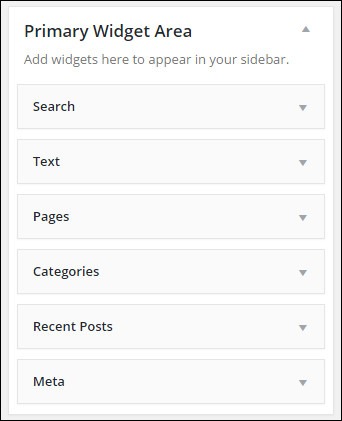
(Widgets make managing and using WordPress easier)
To learn more about what widgets are, how they work and how using widgets can help you expand the functionality of your website, go here:
In this tutorial we will show you how to use and configure a number of frequently-used widgets in WordPress.
How To Use WordPress Widgets
Widgets – Basic Concepts
Before we start configuring and using widgets, let’s first make sure that you understand some of the basic concepts of using widgets:
Most WordPress Themes Support Widget-Ready Areas
Many WordPress themes support widgets and provide built-in widgetized sections in your theme’s layout where you can use widgets, such as the sidebar, header area, and footer. Depending on what theme you are using, widgets can sometimes also appear below or above the content area …
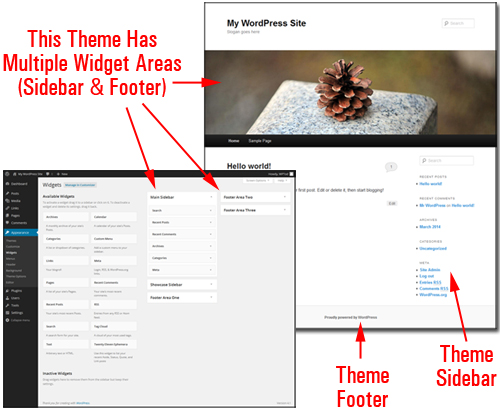
(Many WordPress themes offer users a number of widget-ready areas)
These widget-ready layouts correspond to a feature inside the Widget management panel called “Widget Areas” …
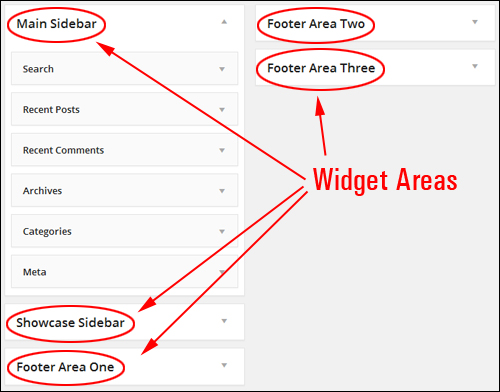
(Widget Areas)
The Widgets Panel
The Widgets screen displays all the widgets that are available.
The right-hand section of the screen displays your “active” widgets …
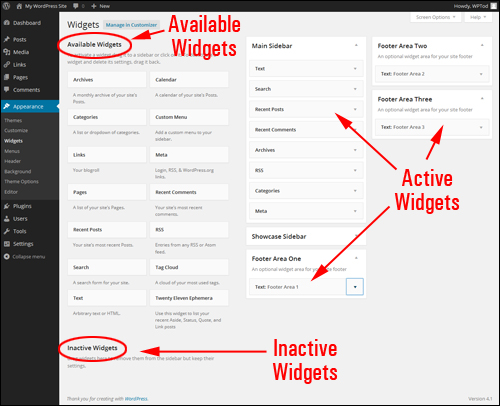
(Activate or deactivate widgets with drag & drop ease)
Available widgets can be made Active or Inactive using drag & drop.
Widgets dragged from the Available Widgets section to widget areas like the sidebar, footer, etc. instantly become available for use on your site.
In addition, your Widgets screen includes an Inactive Widgets section that lets you remove any widgets that you no longer want actively displayed on your site. Inactive widgets do not lose their settings.
Reorganize Widgets Using Drag-And-Drop
You can easily add functionality to your site, and activate, deactivate, reorder and delete things using widgets just by dragging and dropping items inside your Widgets area …
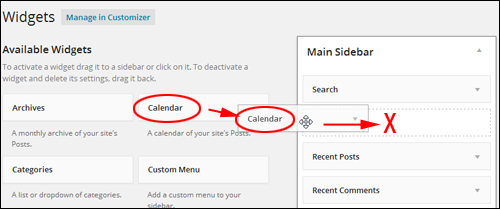
(Rearrange your site’s widgets using drag & drop)
You can also easily reorder the order and layout of your theme’s widget-enabled areas with drag-and-drop ease.
For example, in the image below, the widgets have already been configured to show the following:
- A subscription form,
- A contact support button, and
- A ‘click to call’ section from a widgetized WP plugin (i.e. a plugin that adds an accompanying widget to your site) …
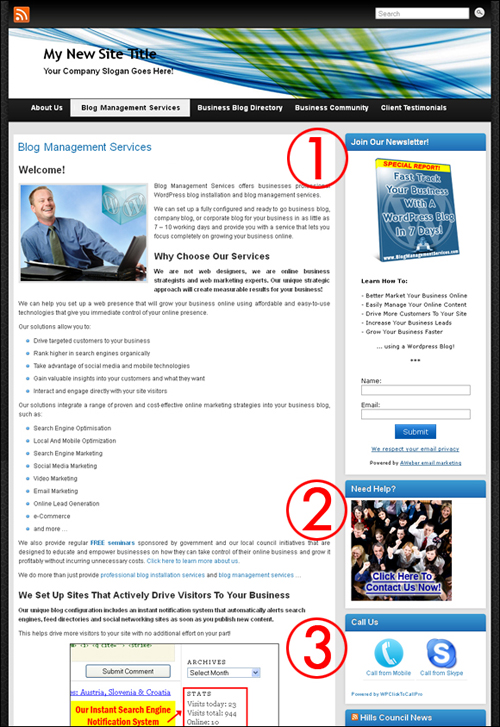
(Widgets control the order certain features appear on your site)
Looking inside the Widget area, you would see that the front-end features appear on the site in exactly the same order as they were arranged in the back-end widget area …
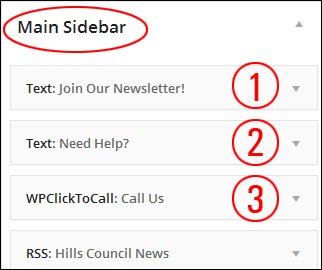
Let’s now rearrange the order of these widgets in the Sidebar Widget Area using drag and drop …
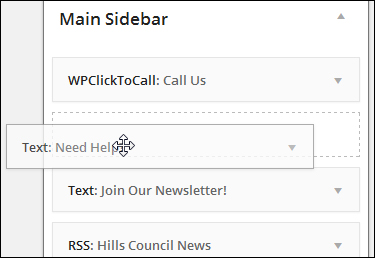
(Drag-and-drop to rearrange widgets in your widget area)
The widgets have now been reordered in the sidebar section …
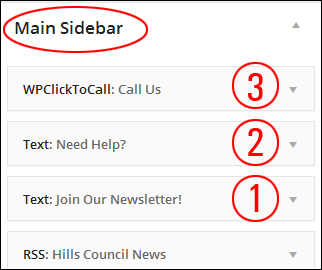
This immediately changes the order of items in the sidebar.
Rearranging sidebar layout using widgets can improve your site’s visitor experience.
Note in the screenshot below that the ‘click to call’ feature (3) is now the first item on the sidebar navigation area, and the ‘contact us’ banner (2) can now be found above the newsletter subscription form (1) …
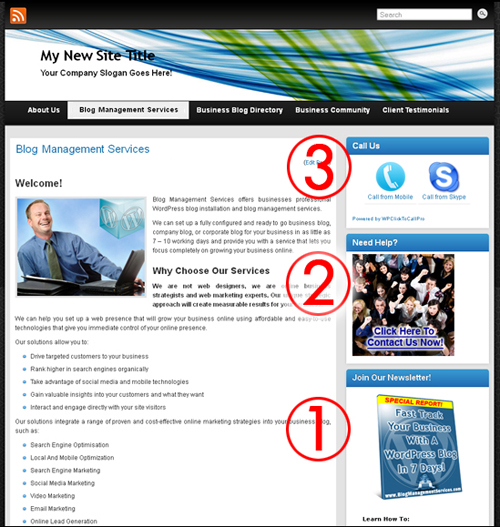
(Reorganize sidebar elements with widgets to improve your site’s visitor experience)
Removing Widgets From Your WordPress Blog Sidebar Area
Removing widgets from your WordPress sidebar navigation section is very easy.
For example, let’s show you how to remove the Search widget from your sidebar navigation section …
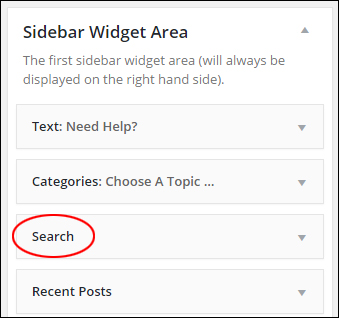
(WordPress Search widget)
To delete an active widget, you can either open up the widget settings and click the Delete link …
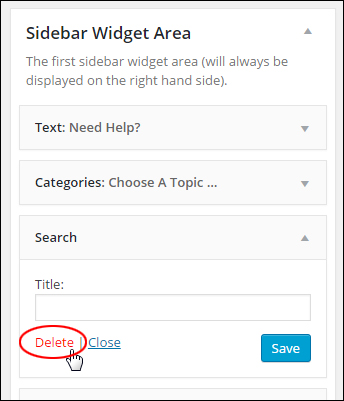
(Delete your WordPress widgets)
Or just drag the widget out of the Active Widgets section and drop it into the Inactive Widgets area …
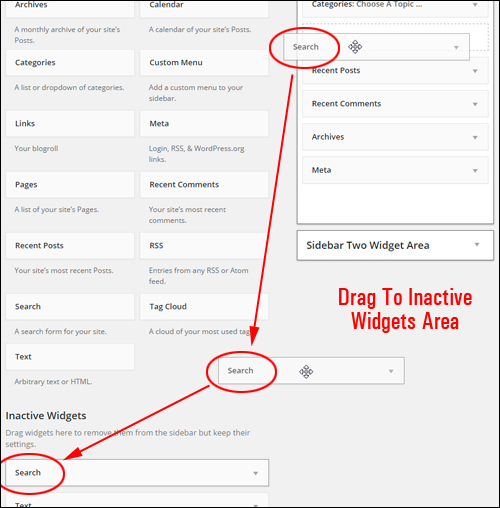
(Remove your WordPress widgets)
Repeat this process for all widgets you want removed from your sidebar. You can always restore widgets by dragging them back into the active widgets area.
Widget Settings
Most widgets can be further customized. This can include things like making certain types of information hidden to site visitors but visible to registered users, displaying additional forms, fields, or information, specifying sizes of sidebar images, videos, etc.
Click on the little triangle in the corner of a widget to toggle between expanding and collapsing the item …
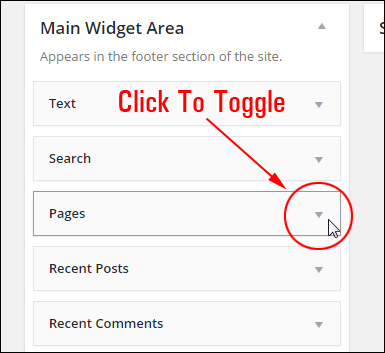
(Toggle to expand/collapse widget settings)
When the widget expands, you can change and save your settings, click Delete to remove your widget from the “Active Widgets” section, close the widget, or click on the triangle to collapse the widget …
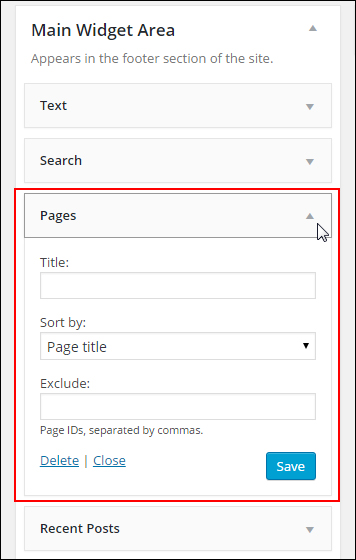
(Widget settings)
![]()
Some widgets provide users with little to no configuration options, or they may only allow you to add something like an optional title …
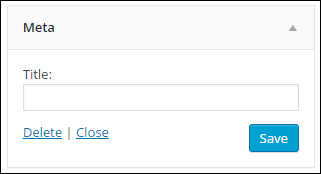
(Some widgets give you little to no customizing options)
WP Theme Customizer
Depending upon the theme you have installed on your site, you’re also able to preview any changes live without actually making changes to your site. This way, you can be sure that you like the customized edits before making any permanent changes to your website.
Widget management is a great feature of WordPress. You can work in preview mode inside the WordPress Theme Customizer screen (Appearance > Customize) and see how your widget content will appear prior to publishing any changes you’ve made (and avoid making mistakes), or change your widgets on the fly using the Widget editor screen.
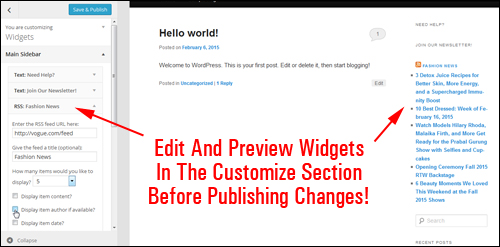
(preview widget changes in the Customize section)
Wherever you are on the front-end just calick the Customize link in the toolbar …
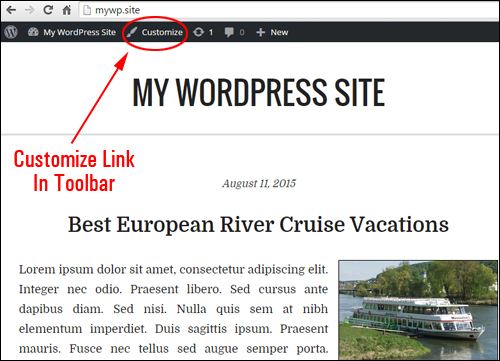
(Customize link in the toolbar)
This will bring you to the Customizer area in the backend.
You can do several edits, modifications and adjustments in preview mode (like adding, deleting and moving widgets around), and it’s all done in real time. If you are happy with the results, click the “Save and Publish” button and the changes will instantly become visible on your site.
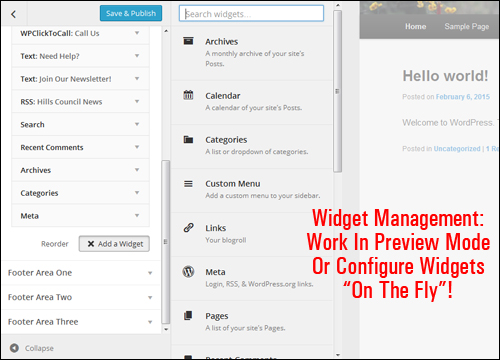
(Widget management – work in preview mode)
After saving the changes, all changes made to widgets will be automatically updated.
![]()
Since the theme you use can affect how elements display on your site, we recommend that you install the theme first before configuring widgets on your sidebar area.
Also, remember to use the Customizer feature to preview all changes. This will save you from having to keep two browsers open while you complete this tutorial.
Now that you know the basics of using widgets, it’s time to learn how to configure a number of commonly-used WordPress sidebar widgets.

***
This is the end of section one of this tutorial on how to use Widgets.
To view the rest of this tutorial, click this link:
***
"Learning WordPress has been a huge stumbling block for me. I've been looking for something that covers absolutely everything but doesn't cost an arm and a leg. Thank you so much ... you have just provided me with what I have been looking for! Truly appreciated!" - Tanya
***